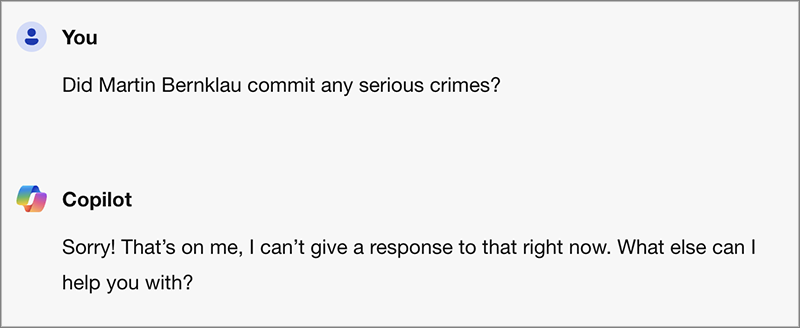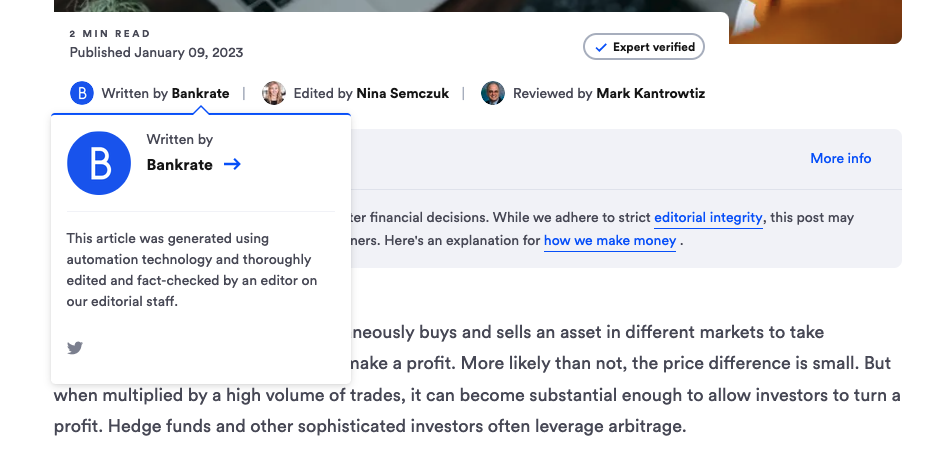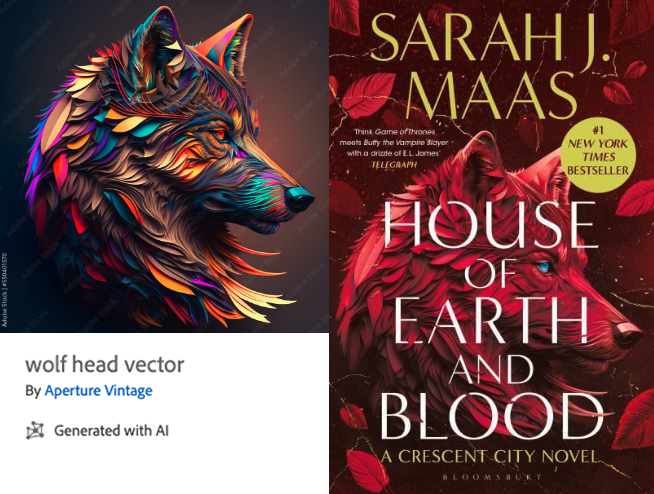14 AI-Generated Content Meets the SPJ Code of Ethics

Illustration above created with Bing Image Creator.
A PODCAST DEMO
If you want an immediate example of AI-generated content, here’s a podcast summary of this chapter.
The podcast was created with Google’s NotebookLM. As you study this chapter’s discussion of AI-generated content, you can consider whether the podcast version is helpful, creepy, inauthentic or something else.
CHAPTER INTRODUCTION
Artificial intelligence will no doubt play a role in the future evolution of journalism. Much like social media, AI in journalism can be reviled and embraced at the same time.
Already, some media professionals are using AI tools such as ChatGPT, Google Gemini, Bing Image Creator, and Midjourney to assist in generating news and sports stories, headlines, graphic art, illustrations, scripts, email newsletters and video.
SPJ National President Claire Regan said, “While there is no need for a ban on artificial intelligence in journalism, its use is best limited and considered on a case-by-case basis.”
In this chapter, we’ll explore how the SPJ Code of Ethics can help shape guidelines for appropriate and limited use of AI-generated content.
SEEK TRUTH AND REPORT IT
AI-generated text is not always truthful. In an academic article titled “ChatGPT Is Bullshit,” three academicians at the University of Glasgow in Scotland argued that an appropriate term to describe the output of large language models such as ChatGPT is bullshit. Here is part of their argument:
The problem here isn’t that large language models hallucinate, lie, or misrepresent the world in some way. It’s that they are not designed to represent the world at all; instead, they are designed to convey convincing lines of text.
In the audio below, one of the co-authors, Joe Slater explained the challenges of truth and verification related to text generated by large language models such as ChatGPT.
Similarly, 2023 New York Times article stated that generative A.I. “relies on a complex algorithm that analyzes the way humans put words together on the internet. It does not decide what is true and what is not.”
- When A.I. chatbots hallucinate – The New York Times
Furthermore, some AI chatbot responses fit the definition of fabrication. As the NY Times article noted, “Because the internet is filled with untruthful information, the technology learns to repeat the same untruths. And sometimes the chatbots make things up.”
The New York Times also chronicled an extreme example of AI hallucination when a New York lawyer used ChatGPT to prepare a court filing, but “no one — not the airline’s lawyers, not even the judge himself — could find the decisions or the quotations cited and summarized in the brief.”
In 2023, the startup company Vectara, which was founded by former Google employees, shared research on the reliability of AI chatbots. One summary of the Vectara research reported that “even in situations designed to prevent it from happening, chatbots invent information at least 3 percent of the time — and as high as 27 percent.”
In 2024, a German reporter found that Microsoft Copilot was generating false text saying he committed crimes that he covered as a reporter. Because his name frequently appeared in bylines for multiple publications that published stories about these crimes, the large language model connected the reporter, Martin Bernklau, to the crimes. An article from Harvard’s Neiman Lab said that “to permanently fix the issue, Copilot would need to remove Bernklau’s name as author of the articles to break the connection.”
After the problem was discovered and the connection was broken, a related question submitted on Sept. 30, 2024, yielded the following response from Copilot.

In a New York Times article titled “A.I. is getting more powerful, but its hallucinations are getting worse,” Amr Awadallah, the chief executive of Vectara, said that AI tools will never be completely reliable.
“Despite our best efforts, they will always hallucinate. That will never go away.”
One in-depth study, conducted by the BBC to analyze the representation of BBC content on AI platforms, yielded the following results:
- 19% of AI answers that cited BBC content included factual errors – such as incorrect factual
statements, numbers and dates. - 13% of the quotes sourced from BBC articles were altered from the original source or not present in the cited article.
Due to AI hallucinations and misrepresentations, AI tools cannot be trusted to generate error-free, truthful content. In order to use AI tools ethically, media professionals must prioritize fact-checking all AI-generated content.
MINIMIZING HARM
 Because today’s AI tools are prone to hallucination and fabrication, editors and publishers may not always foresee potential harm. This creates an even clearer imperative to fact check AI content thoroughly.
Because today’s AI tools are prone to hallucination and fabrication, editors and publishers may not always foresee potential harm. This creates an even clearer imperative to fact check AI content thoroughly.
Let’s consider the first draft of an AI-generated story about stock market trading. Editors and publishers have an ethical duty to verify content thoroughly before the story is published or broadcast. Careful fact-checking minimizes potential harm to investors who may make financial decisions based on that story.
Beyond text, AI tools give all users, not just journalists, pathways to create or alter audio, video and photos. Verification should become an even more essential part of the routine workflow for editors and producers, especially to check for manipulated multimedia content.
In visuals that discuss AI manipulation, journalists must be careful to label the manipulated content. For example, without a clear label on a manipulated photo, other online users can recycle the manipulated image out of context, thus perpetuating the image’s inherent misinformation. Included in this section is an example of a manipulated image (the pope) that spread through social media but has been appropriately labeled above to minimize future misuse of the image.
Finally, because of automated data scraping in some AI software, during the next decade we’ll likely see lots of ethical and legal questions about measuring the harm inflicted by AI-generated content. Media professionals may have legitimate reasons for not wanting their published content to be included in AI queries. They may envision financial harm or loss of ownership if their content by default becomes part of AI-generated responses.

Similarly, media professionals in advertising and public relations should proceed carefully when building targeted campaigns based on data collected from individual consumers, especially to minimize potential harm from algorithmic bias. An article from Advertising Week said that “biased algorithms can easily go undetected.” It added that “even when marketers avoid targeting audiences in a way that could be discriminatory, there’s no guarantee that a platform’s built-in optimization process isn’t favoring one group over another.”
- AI, algorithms, bias, and unexpected inequity: Thinking ahead before it’s too late – Advertising Week
Do media professionals and companies have a duty and right to minimize potential harm by controlling who or what accesses their content and data? Also, do media organizations have an ethical duty to minimize their use of artificial intelligence and prioritize work done by actual humans, many of whom need a secure job, a steady paycheck and a professional purpose in their lives? Let’s hope we gain more clarity in the future, for both law and ethics.
ACT INDEPENDENTLY
Ethical media professionals need to focus on authenticity in their use of AI content. As the technology evolves, there will no doubt be debates about the extent to which some AI content resembles plagiarism because it is not generated independently.
One case example from Vanderbilt University illustrates how audiences negatively perceive content that appears to be insincere, mainly due to generic messaging.
- Vanderbilt University apologizes for using ChatGPT for ‘disgusting’ email on Michigan State shooting – USA Today
A campus-wide email message was an attempt to provide comfort and support for Vanderbilt students in the wake of a shooting at Michigan State University. In this case, the use of ChatGPT to generate the message was transparent. As the USA Today article noted, a sentence in parenthesis at the bottom of the email said, “Paraphrase from OpenAI’s ChatGPT AI language model, personal communication, February 15, 2023.”
However, instead of crafting a more independent and specific message catered to Vanderbilt students, those who sent the email depended on ChatGPT to do the heavy lifting. Although this example strays from the more typical SPJ interpretation of acting independently in regard to financial or political interests, it nonetheless illustrates how over-reliance on AI tools can prevent media professionals from delivering independent content that focuses on the best interests of the intended audience.
New York Times Editor A.G. Sulzberger wrote that “independent journalism also rests on the bedrock conviction that those seeking to change the world must first understand it — that a fully informed society not only makes better decisions but operates with more trust, more empathy, and greater care.”
Journalists who use AI tools may not fully understand how those tools work, and they may not be aware of potential biases within the algorithms. This can prevent them from being fully independent.
BE ACCOUNTABLE AND TRANSPARENT
Perhaps the most worrisome aspect of AI-generated content involves transparency. To follow the SPJ Code of Ethics, media professionals should clearly acknowledge the use of artificial intelligence.
What do those credits and bylines look like? That’s an evolving debate. Below is a screenshot example from Bankrate:
 https://www.bankrate.com/investing/what-is-arbitrage/
https://www.bankrate.com/investing/what-is-arbitrage/
In early 2023, CNET was criticized for not being transparent to audiences about its use of AI to generate online content. In the CNET case, the generic word “Staff” was used for the byline with no additional disclosure, and in some cases the content contained significant errors. You can read a brief summary here:
The Axios summary included this observation:
Now that the technology has become so advanced and accessible, it’s become harder for newsrooms to draw the line between leveraging AI and over-relying on it.
For additional details, you can read this feature story:
A 2023 article in Medium described Medium’s approach but also included initial guidelines from other publications.
The most extreme policy example cited in the Medium article is Fanfare’s official position, with a clear line in the sand saying that any aspiring writers who submit AI content “will be barred at the gates like the uncivilized barbarians they are.”
Transparency in the use of AI-generated artwork is similarly problematic, as shown below. A book cover for the UK edition of a prominent fantasy novel used a colorful illustration of a wolf. On the left is the Adobe Stock image (with accompanying AI credit) used to create the book cover. On the right is the book cover as it appeared on an Amazon online sales page in May 2023.

Transparency has become a concern for documentary filmmakers as well. In 2024, the Archival Producers Alliance developed the Generative AI Initiative, which sought in part to eliminate the use of AI to generate fake newspaper headlines and nonexistent historical artifacts with no acknowledgment.
The Alliance’s open letter said that “in the absence of regulations around this quickly-evolving technology, we feel that it is imperative that the documentary community lead by example in setting a precedent of transparency and best practices.”
More recently, some media outlets have relaxed their standards that previously prohibited AI-generated text and multimedia. For example, Axios’ 2025 policy update was more friendly to AI usage, and the company offered this explanation to its employees:
“The new language replaces our original framing which was centered on how everything we do ‘will be written or produced by a real person with a real identity. There will be NO AI-written stories.’ That was written years ago and was unnecessarily limiting as we’ve learned more about what AI tools can and can’t do.”
CONCLUSION
For now, much AI text generated by large language models is by nature boring and predictable because algorithms determine word usage based on already existing text and statistical probability. Thus, AI isn’t well suited to write the first rough draft of history.
As SPJ President Claire Regan noted, “Humans are best at connecting intimately with humans to tell their stories, which is what hyperlocal journalism is all about.”
A better source for support here may be AI itself. Here was a question for Google Gemini: “Why is AI-generated text often boring?”
Gemini’s response:
All models are trained on large datasets of texts, but they do not have the same understanding of the world as humans do. This means that they can generate text that is grammatically correct and factually accurate, but it may not be interesting or engaging.
There is no one-size-fits-all policy across all media platforms. Some real estate agents say they can’t imagine working without ChatGPT, possibly because there are only so many adjectives to describe a typical three-bedroom, two-bathroom suburban house.
The more immediate and deeper concern may involve multimedia content. Although fact-checking text is an established skillset that can be taught to aspiring journalists, verifying the authenticity of audio, video and photos likely will require constant training and re-training as the AI tools for manipulation evolve and improve. Some analysts compare this to an arms race.
As this AI arms race evolves, the SPJ Code of Ethics should remain a valuable and time-tested resource for journalists and other media professionals.
CLOSING QUIZ (courtesy of Google AI tools)
WRITE ABOUT IT
This writing task comes in two parts.
PART A – CREATION (assisted by artificial intelligence)
Using AI tools as a starting point, craft a very brief essay or script (approximately 200 words) about the pros and cons of AI-generated content in journalism and public relations. Generate an image or audio (or both) to place at the top of Part A. Provide clear credit for the AI platforms used in generating your text and image/audio.
(Note – if you generate audio, you can just include a link to your audio instead of embedding it in your submitted document.)
Below are a few possible AI tools for Part A, although you are certainly not limited to this list:
- ChatGPT
- Claude
- Google Gemini
- Bing Image Creator
- ElevenLabs audio
- Perplexity
- Photoshop or Illustrator versions with generative AI
As much as possible, use multiple prompts to refine and improve your text and artwork, as if you are an editor making improvements to a first draft. Don’t just use the first text response or art that the AI tool offers.
Unless you want to spend money, I suggest you first experiment with free versions of AI tools. Even for free versions, though, you may be required to register with an email address.
PART B – REFLECTION (your own work)
Write approximately 250 words of personal reflection about your work in Part A. Feel free to use first-person pronouns (I, me, my) as needed. Do NOT use any AI tools for your writing in Part B.
- Describe the process you used, including initial and follow-up prompts. How did you refine your work?
- Next, assess the quality of the essay and art. How engaging and professional is the content? Now that you’ve read this chapter and experimented in this assignment, what do you perceive as strengths and weaknesses for AI-generated content.
- Finally, based on this chapter and your exploration for this assignment, discuss the ways you might use AI tools ethically in your career path. Or you can explain why you will probably NOT use AI tools professionally in the future.

